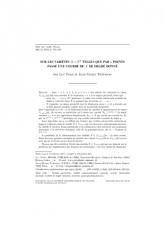Sur les variétés $X\subset \mathbb {P}^N$ telles que par $n$ points passe une courbe de $X$ de degré donné
On varieties $X\subset \mathbb {P}^N$ such that a curve of $X$ of given degree passes through $n$ points of $X$

- Consulter un extrait
- Année : 2013
- Fascicule : 1
- Tome : 141
- Format : Électronique
- Langue de l'ouvrage :
Français - Class. Math. : 14N (14M22, 14J40), 53A (53A40, 53C10).
- Pages : 131-196
Soit $\,r\geq 1$, $\,n\geq 2$, et $\,q\geq n-1$ des entiers. On introduit la e $\mathcal {X}_{r+1,n}(q)$ des sous-variétés $X$ de dimension $r+1$ d'un espace projectif, telles que
- pour $(x_1,\ldots ,x_n)\in X^n$ générique, il existe une courbe rationnelle normale de degré $q$, contenue dans $X$ et passant par les points $x_1,\ldots ,x_n$ ;
- $X$ engendre un espace projectif dont la dimension, pour $r$, $n$ et $q$ donnés, est la plus grande possible compte tenu de la première propriété.
Variété projective, variété rationnellement connexe, courbe rationnelle normale, variété de degré minimal, stucture quasi-grassmannienne.

